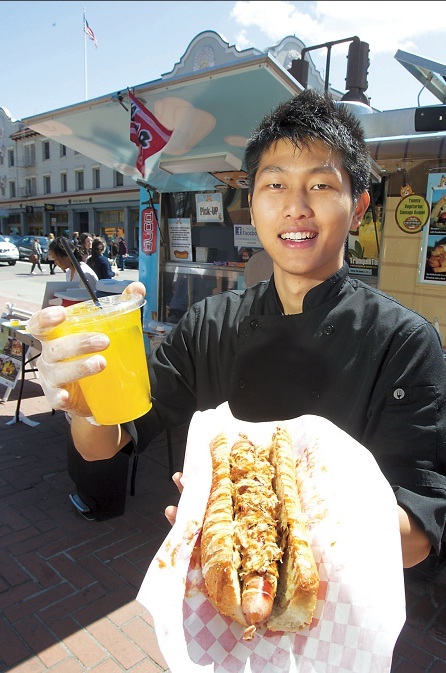SAN JOSE ― The saga of the hot dogs began late one night.
University of California-Berkeley junior Michael Koh and his friends had followed up their study session with a few beers and a quick jaunt to Berkeley’s venerable Top Dog for some buns on the run. In fact, it was such a quick jaunt they rushed right past the condiments, completely forgetting that a frankfurter sans ketchup or mustard is a sadly naked dog. And being college students, they didn’t have what you might call a well-stocked fridge.
“We’re all Asian,” Koh says, “so all we had was a bottle of teriyaki.”
Turns out, a teriyaki-topped hot dog tastes pretty decent. The fusion experiments that followed ― katsu sauce, shredded nori, wasabi! ― tasted even better. And when Koh added some sly names to his creations, he had a hit on his hands.
These days, every Cal kid can get their hands on a Shaolin Monk hot dog, a Wushu frank or a Ninjitsu, topped with flash-grilled cabbage, shredded nori and, in an homage to the condiment that started it all, teriyaki sauce.
Other college students make ends meet by playing barista or washing dishes in the dining hall, but Koh, an environmental econ major, has gone entrepreneurial instead. His street food truck ― the bright blue Dojo Dog food cart ― opened shop just a few yards from Sproul Plaza in January.
As for those hot dog monikers, they are a nod to the martial arts combat techniques Koh admires, even if he can’t actually do them.
“They never worked out for me, ” he says. “But we wrap (the hot dog) with the diet of a Shaolin Monk.”
 |
Michael Koh, a 19-year-old University of California student, serves up his signature Dojo Dogs in Berkeley, California, on April. (MCT) |
That would be the low-carb, seaweed-wrapped option. The other hot dogs come on hoagie-style rolls.
Koh may be the first undergrad to run his own food truck at Cal, but street food fever is taking over not only cities, but also college campuses from coast to coast. Schools in Southern California, Texas, Oregon and Washington have launched their own versions of Off the Grid street food fests, bringing fleets of food trucks on campus. A trio of students at Bowdoin College in Maine launched a food truck in February. And law students in Pennsylvania have begun holding workshops for anyone interested in starting a food truck business of their own.
There’s no doubt that street food trucks are hot, says Matt Cohen, founder of Off the Grid, which hosts food truck gatherings in Berkeley, San Mateo and San Francisco. But most people who run trucks these days are line cooks or chefs who decided to go solo, or caterers looking to branch out. In other words, professionals.
“(But) the original nouveau food trucks were run by foodies, ” Cohen says. “They think, ‘I’m going to start a restaurant!’”
Koh was one of those. He had dreamed of opening a restaurant someday, he says, “But because of the capital investment, I had to basically start off a little bit humble. I looked into street food.”
Of course, it doesn’t take a CPA to figure out that a food truck is significantly less expensive to launch than a bricks-and-mortar eatery. And if you take the secondhand food cart option, as Koh did, the costs drop even further, which makes it a viable option for an entrepreneurial foodie, especially one as intrepid as Koh.
Koh was just 16 when he decided he wanted to “explore the world.” And the fact that he didn’t speak any English didn’t stop him from packing up and moving from his parents’ home in Taiwan to San Mateo, where he set up housekeeping in an apartment his father keeps here and enrolled in high school. Nothing, he says, gets in the way of a dream.
But even Cohen is impressed that an undergrad took the plunge and that Koh managed to score one of Berkeley’s, much-coveted, four-year contracts ― Koh’s runs through December 2015 ― and that he put the whole deal together, bureaucratic red tape and all, while studying for final exams.
“That was a nightmare,” Koh concedes.
Koh had filed for the permit last summer but hadn’t bought the cart, finessed the menu or begun the protracted business of getting city, county and health department approval until he got the formal OK from the university. Which meant he had five weeks to do everything ― while cramming for exams.
It probably helped, he says, that he didn’t know what he was getting into, until he was up to his neck in it.
So, would he do it again?
“That’s debatable,” he says. “I’m enjoying it a lot, but I’d enjoy being a normal student, partying, going to Top Dog. There’s definitely trade-offs, but it’s made my life a lot more colorful.”
Meanwhile, his parents have no clue that their globe-trotting son owns his own business now. They just think he’s been really busy.
“My dream is they’re going to come visit me for my graduation,” he says. “I’ll take them to the cart, and after they finish, I’ll say, ‘By the way, this is mine.’”
INSIDE A DOJO DOG
Asian fusion fare is hardly a novelty, but when the culinary areas being fused involve hot dogs, seaweed and martial arts combat techniques, it looks something like this:
● Ninjitsu: A Dojo Dog dog topped with shredded nori, flash-grilled cabbage, teriyaki sauce and Japanese mayonnaise, in a hoagie-style bun.
● Kendo: Bonito flakes, cabbage, soy paste and wasabi mayonnaise.
● Wushu: Pork sung, cabbage, katsu sauce and Japanese mayonnaise.
● Shaolin Monk: Lettuce, grilled cabbage and a miso glaze, wrapped in nori rather than a bun.
By Jackie Burrell
(San Jose Mercury News)
(MCT Information Services)








